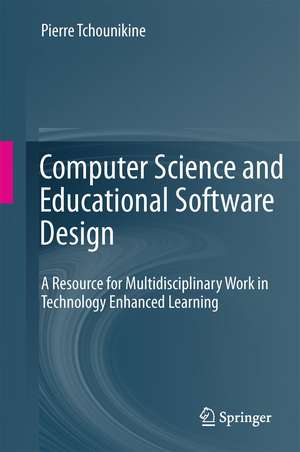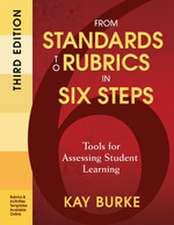Computer Science and Educational Software Design: A Resource for Multidisciplinary Work in Technology Enhanced Learning
Autor Pierre Tchounikineen Limba Engleză Paperback – 7 oct 2014
Tchounikine argues that these difficulties cannot be solved by building a kind of “general theory” or “general engineering methodology” to be adopted by all actors for all projects: educational software projects may correspond to very different realities, and may be conducted within very different perspectives and with very different matters of concern. Thus the issue of understanding each others’ perspectives and elaborating some common ground is to be considered in context, within the considered project or perspective. To this end, he provides the reader with a framework and means for actively taking into account the relationships between pedagogical settings and software, and for working together in a multidisciplinary way to develop educational software.
His book is for actors engaged in research or development projects which require inventing, designing, adapting, implementing or analyzing educational software. The core audience is Master’s and PhD students, researchers and engineers from computer science or human and social sciences (e.g., education, psychology, pedagogy, philosophy, communications or sociology) interested in the issues raised by educational software design and analysis and in thevariety of perspectives that may be adopted.
| Toate formatele și edițiile | Preț | Express |
|---|---|---|
| Paperback (1) | 382.36 lei 6-8 săpt. | |
| Springer Berlin, Heidelberg – 7 oct 2014 | 382.36 lei 6-8 săpt. | |
| Hardback (1) | 386.81 lei 6-8 săpt. | |
| Springer Berlin, Heidelberg – 29 iun 2011 | 386.81 lei 6-8 săpt. |
Preț: 382.36 lei
Nou
Puncte Express: 574
Preț estimativ în valută:
73.17€ • 75.93$ • 61.16£
73.17€ • 75.93$ • 61.16£
Carte tipărită la comandă
Livrare economică 15-29 martie
Preluare comenzi: 021 569.72.76
Specificații
ISBN-13: 9783642443121
ISBN-10: 3642443125
Pagini: 196
Ilustrații: XIII, 180 p.
Dimensiuni: 155 x 235 x 10 mm
Greutate: 0.28 kg
Ediția:2011
Editura: Springer Berlin, Heidelberg
Colecția Springer
Locul publicării:Berlin, Heidelberg, Germany
ISBN-10: 3642443125
Pagini: 196
Ilustrații: XIII, 180 p.
Dimensiuni: 155 x 235 x 10 mm
Greutate: 0.28 kg
Ediția:2011
Editura: Springer Berlin, Heidelberg
Colecția Springer
Locul publicării:Berlin, Heidelberg, Germany
Public țintă
ResearchCuprins
Introduction.- A General Conceptualization for Educational Software.- Understanding Differences in Perspectives.- Review of Prototypical Examples.- CS Perspectives and TEL.- Educational Software Engineering.- Characterizing the Design Context and the Software Artifact.- Methodological Considerations.- Conclusions.
Recenzii
From the reviews:
“This book considers the design and implementation of educational software from a theoretical point of view. … All necessary notions for understanding the book are well defined and explained. … The book provides a very good set of items for educational software engineering that may be used to characterize the educational setting. … This book is for professionals engaged in research or development projects that require inventing, designing, adapting, implementing or analyzing educational software and related issues.” (Thomas Borys, Zentralblatt MATH, Vol. 1245, 2012)
“This book considers the design and implementation of educational software from a theoretical point of view. … All necessary notions for understanding the book are well defined and explained. … The book provides a very good set of items for educational software engineering that may be used to characterize the educational setting. … This book is for professionals engaged in research or development projects that require inventing, designing, adapting, implementing or analyzing educational software and related issues.” (Thomas Borys, Zentralblatt MATH, Vol. 1245, 2012)
Notă biografică
Pierre Tchounikine, PhD, is Full Professor of Computer Science at the University of Grenoble (France). He is presently leader of Grenoble’s multidisciplinary research team (40 persons) edicated to Technology Enhanced Learning (TEL). He has been involved in the construction and leadership of the European Network for Excellence Kaleidoscope (over 1.000 researchers from different disciplines involved in TEL) and is now leading Grenoble’s participation to the Stellar European network. He serves in the International Society for the Learning Sciences educational committee (since 2008) and has been member of the Artificial Intelligence and Education executive committee (2003-2011). As a Computer Science re-searcher involved for 20 years in the TEL field, reviewer of many articles and projects, supervisor and reviewer of many PhD theses, he has developed a specific interest in analyzing and conceptualizing the relations and issues related to the Computer Science dimensions of TEL seen as a multidisciplinary field.
Textul de pe ultima copertă
- Truly interdisciplinary approach to combine the viewpoints of computer scientists and educational actors
- Provides practical and context-related hints on how to deal with the peculiarities of educational software design and development
- Complemented by several examples illustrating issues and propositions
- Based on the author’s more than 20 years’ experience in projects on technology-enhanced learning
Tchounikine argues that these difficulties cannot be solved by building a kind of “general theory” or “general engineering methodology” to be adopted by all actors for all projects: educational software projects may correspond to very different realities, and may be conducted within very different perspectives and with very different matters of concern. Thus the issue of understanding each others’ perspectives and elaborating some common ground is to be considered in context, within the considered project or perspective. To this end, he provides the reader with a framework and means for actively taking into account the relationships between pedagogical settings and software, and for working together in a multidisciplinary way to develop educational software.
His book is for actors engaged in research or development projects which require inventing, designing, adapting, implementing or analyzingeducational software. The core audience is Master’s and PhD students, researchers and engineers from computer science or human and social sciences (e.g., education, psychology, pedagogy, philosophy, communications or sociology) interested in the issues raised by educational software design and analysis and in the variety of perspectives that may be adopted. In addition, it is also of interest for teachers engaged in, for example, ICT-based innovations.
Caracteristici
Truly interdisciplinary approach to combine the viewpoints of computer scientists and educational actors Provides practical and context-related hints on how to deal with the peculiarities of educational software design and development Complemented by several examples illustrating issues and propositions Based on the author’s more than 20 years’ experience in projects on technology-enhanced learning Includes supplementary material: sn.pub/extras











